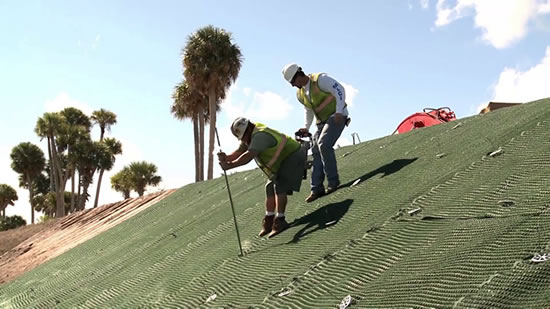Propex GeoSolutions has opened July with some welcomed sustainability news. The company became the first High Performance Turf Reinforcement Mat (HPTRM) manufacturer to verify the carbon footprint of its erosion control solutions.
The cradle-to-grave carbon footprint of PYRAMAT® 75 HPTRM, one of Propex’s key materials, is 2.7 kgCO2e per 1m2 of material. This equates to driving about seven miles.
“This verification is another piece of the sustainability puzzle,” said Mike Gorey, CEO of Propex Operating Company, LLC. “We’ve known for 20 years that our erosion control solutions support the environment by encouraging vegetation and improving water quality, but now we know that their lifecycle produces a small carbon footprint.”
HPTRM CARBON FOOTPRINT VERIFICATION
PYRAMAT turf reinforcement mats are utilized in multiple well-known erosion control systems, including ARMORMAX®, SCOURLOK®, and PYRAWALL®. These solutions help reduce emissions, increase vegetation, and support living shorelines.

Confirming a carbon footprint value for PYRAMAT has been part of a 20-year process, going back to the EPA’s 1999 Storm Water Technology Fact Sheet on Turf Reinforcement Mats. That publication recognized the importance of erosion control solutions like PYRAMAT as a Best Management Practice for providing long-term water quality benefits.
RELATED: Propex on TRM Durability and UV Performance
Over the years, as sustainability calculation methods and standards were refined, new opportunities to confirm the carbon impact value of construction materials such as erosion and sediment control materials were refined. Propex’s investment here to draw attention to these materials is admirable and may inspire others to follow suit.
To gain recognition, Propex engaged the environmental standards certification and development entity SCS Global Services, which evaluated PYRAMAT’s lifecycle to calculate the cradle-to-grave carbon footprint. The result was then verified through an additional independent third-party review by Dr. Tom Gloria of Industrial Ecology Consultants.
The criteria were significant. Requirements included:
- The Greenhouse Gas Protocol: Product Life Cycle Accounting and Reporting Standard World Resources Institute/World Business Council for Sustainable Development (Sept. 2011)
- PAS 2050:2011 Specification for the assessment of the life cycle greenhouse gas emissions of goods and services. British Standards Institution
- ISO 14064-3:2006 Specification with guidance for the validation and verification of greenhouse gas assertions
“Verification of PYRAMAT’s carbon footprint ensures the accuracy and thoroughness of its reported greenhouse gas emissions,” said Keith Killpack, Technical Director for SCS Global. “Product carbon footprints serve as benchmarks against which product improvements can be measured, and provide customers with information about a product’s climate impact to inform their purchasing decisions.”
Propex invites all to learn more about its environmental commitment.











